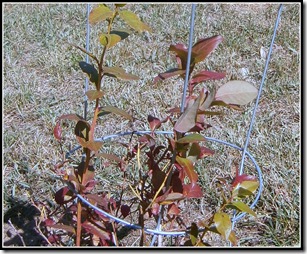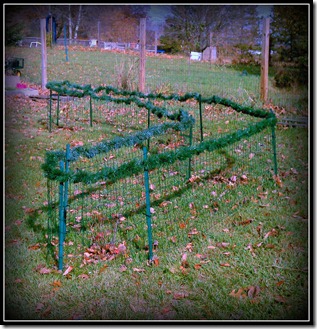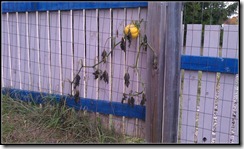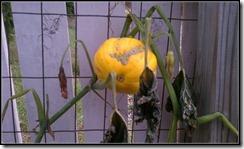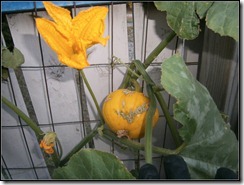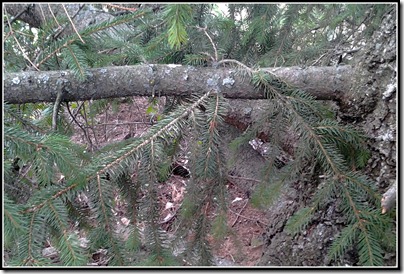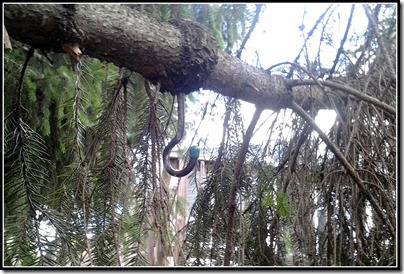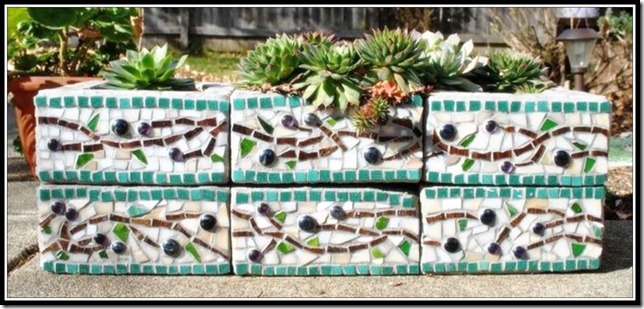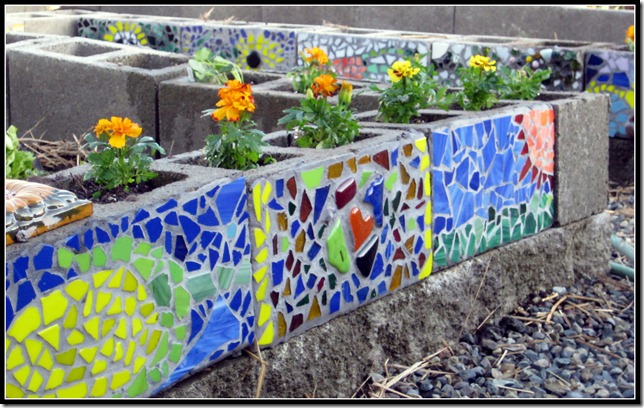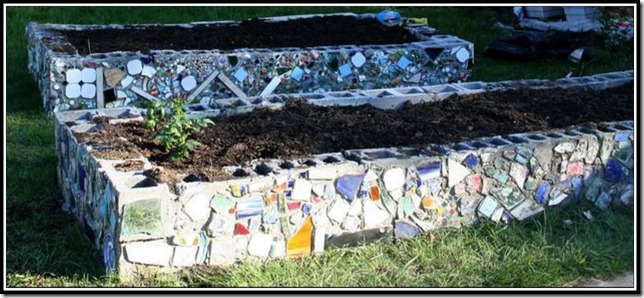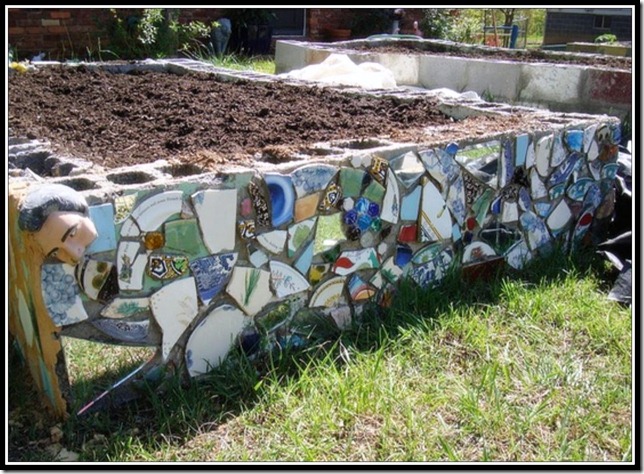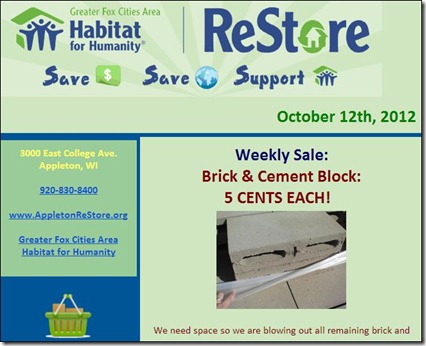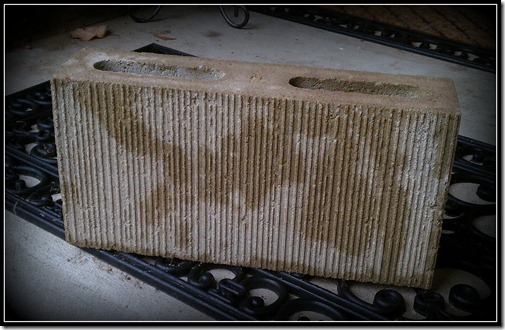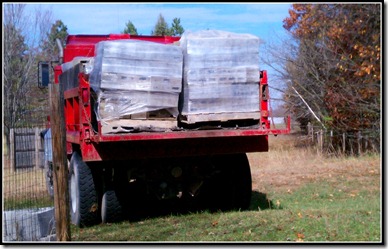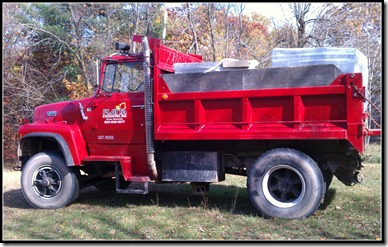So I had to protect them from dogs and people walking over them but the tomato cages clearly weren’t bright enough since I almost fell over one while walking through the yard. So… what else… green fencing with leftover green Christmas greenery… remember it going to snow!!!
.....just a journal of mostly photos of my gardening adventures... minus the backlog of over 1000 photos not yet uploaded! Also, I find myself collecting some recipes and just good ideas so this is the perfect place to put them. More pictures are on Pinterest at pinterest.com/laurelWisconsin.
Wednesday, October 24, 2012
Thursday, October 18, 2012
Wednesday, October 17, 2012
the pine tree
I found it interesting that there was new growth where other had died off… and then I found the hook embedded in the branch.
Sunday, October 14, 2012
Concrete block art
OMG! 5 cent cement blocks!
Got the weekly email from ReStore on Friday… Concrete blocks – 5 cents! I’m there… NO they won’t sell them to me Friday night. Saturday morning… thunderstorm and pouring rain. Didn’t matter – off I go. Just what I wanted – 4 x 8 x 16 – brand new and with a design on the one side. Yep.. I’ll take them all. Guy counts them and brings it to the register. I get in line to check out. $30 some – not so bad. Bring one home with me. Figure out how many there are…. OMG – 675!!
OK… to justify it.. one raised bed 20 feet long like I have – 2 blocks wide – 3 blocks high – uses 108 blocks… Actually I think it won’t take me long to use them. 4 blueberry bushes need protection from the dogs and me walking on them… another 40. Front yard wall I’ve been thinking about since I liked the fence so much that I put up for Olivia (it keeps the other dogs in if I want to sit out front and I don’t have to worry about them chasing rabbits – oh and was really cool when the puppies came to visit and we could sit out front and let them loose.) hhmmm…. 150 blocks first layer times 3 high is 450 blocks for a raised bed so I can plant something … ok.. I’m almost out of blocks.
NOW… to get them here…. just a small detail!
update: Guy with a truck – a very large truck….
…Now to get them unloaded…. clearly I didn’t think this totally through…
Saturday, October 13, 2012
Homemade Stevia Syrup
Posted by Jaime W. in Chemical-Free Living, Living on pennies, Recipes
August 30, 2012
So, I had this brilliant idea while walking around a plant nursery early this spring. On a shelf near the herb section, I saw a little stevia plant. Stevia! I can grow my own stevia! It’s natural! It’s fairly easy to grow! It’s not horribly fatsy like sugar! I’ll never have to buy sweetener again!
Here’s my (somewhat overgrown) stevia plant, next to my cute little basil plant.
Proud of my genius, I made the investment—I bought the plant. I’d love it. I’d nurture it. I’d have it forever, and I’d never ever ever have to buy stevia in any form again. It was going to be awesome.
It wasn’t until a few weeks later, when the plant started to grow so large that it was flopping over the edges of the pot, that I suddenly realized—wait, what do I do with this, exactly? I asked around a bit, and got the same exact enthusiastic answer from five different trusted gardeners. “Throw a few leaves in with your iced tea!” Okay, yes, that’s great—but seriously, how much iced tea can a person drink? Besides, that eliminated my need for sugar in exactly one recipe—not even a recipe I made very often!
I finally decided to trim and dry a few of the leaves. I’d done it a few years before with my excess fresh basil, and it was simple enough. I’d just use what I could fresh, and dry the rest! Problem solved, right? Except what in the world do I do with dried stevia leaves? More tea??? No. I need something more flexible. I need something that I can add to recipes without it looking like I’ve poured Italian seasoning in my dessert. I had to find a way to make my stevia more versatile.
Get ready for this: Stevia Syrup! Perfect for adding to tea, coffee, lemonade, smoothies, fruit crisps and cobblers, pie fillings, homemade yogurts and kefirs, your morning oatmeal—if it won’t miss the added bulk of sugar (some recipes do need that 1 cup of sugar, because it fills out the recipe), stevia syrup will work. There are even recipes for baked goods that use only stevia (or mostly stevia) as the sweetener. It’s up to 200 times sweeter than sugar, so you only need a tiny bit—it won’t add too much liquid to your recipes.
I let my coarsely chopped stems and leaves soak (covered) for about 36 hours.
Here’s the recipe:
3 c. of distilled (purified) water
3 c. of chopped stevia leaves and stems (loosely packed)
Place the chopped leaves in a glass container and add 1 c. of the water. Cover tightly and let sit for 24 hours. Test for sweetness. If it isn’t sweet enough, give it another 12 to 24 hours. Strain it into a pan (ceramic is best),and bring to a simmer. Let simmer for 20 minutes; cool.
The longer it reduces, the more potent the sweetness.
Don’t get greedy with the sweetness. I was tempted to do it, too. “If letting it sit longer makes it sweeter, I’ll let it sit all week!” Not a good idea, evidently. Ever had something sweetened with stevia that had a funky, bitter aftertaste? It’s because someone got greedy. Don’t let it sit any longer than 48 hours—and less is more!
It’s a very earthy green color–but that just means more nutrients! Don’t worry, it won’t dye your food.
This needs to be refrigerated, and it will last at least a few weeks in the fridge. To keep the batches coming even when your lil’ stevia guy goes into slow winter growth mode, dry leaves when you have an abundance, and use the dried leaves to make fresh batches of syrup. The strength probably won’t be identical, so check it a few times during steeping.
I put about a spoonful in my plain yogurt (see the green?), and it was just the right amount of sweetness.
Stevia powder is another option—and it’s a bit simpler, too. Just dry the leaves and then grind them with a mortar and pestle, or a coffee grinder if you have one. The powder will work just like the syrup does—provided you don’t mind the green color and the texture of the powder in your food and drink (which I do, hence the syrup).
I hope you try it, and here’s to healthier eating habits!
Tuesday, October 2, 2012
Extending Your Growing Season with Mini Greenhouses
From Gardner Scott http://gardenerscott.blogspot.com/2011/03/extending-your-growing-season-with-mini.html
Gaining a few extra weeks in your growing season might make the difference between harvesting a handful of tomatoes and harvesting a bushel. With a little effort and not much money, you can add weeks to your season on both the front side and the back.
I strongly advocate raised beds if you want an extended season. The soil in raised beds thaws out faster in the spring. After a few recent warm days I tested my soil yesterday. The soil in open areas that receive full sun is still frozen below about two inches. The soil in my raised beds is thawed down to six to eight inches, depending on how much sun they get. Raised beds are also ideal for mini greenhouses.

A mini greenhouse over my raised bed.
A mini green house is a simple structure that is built over the raised bed, or in the garden, and covered with plastic. It lets the sun's rays through during the day and traps radiant heat at night.
Mini greenhouses will warm the soil faster, help retain heat through the night, and protect plants during the variable days of late spring. The last two to three weeks before your last frost date (see my blog "Know Your Important Garden Dates"; Jan 20, 2011) may still present a few nights where the temperatures drop below freezing. The extra protection makes a big difference; studies by Colorado State Universityshowed a plastic-covered frame provided three to six degrees of frost protection. That's all you need to plant early and not be worried.
I built my mini greenhouses as "hoop houses" using 1/2" PVC pipe. In my four feet by eight feet raised beds, I installed 3/4" pipe "C" clamps every two feet along the side edges of the bed. Take a 10-feet long PVC pipe and bend it between the clamps. This forms a hoop. An eight-foot long, 1" x 2" board can be screwed to the hoops at the top center to form a backbone that holds them in place.

The clamps that hold the PVC pipe in place.
Cover the hoops with a sheet of plastic. Plastic that is 10-feet wide is a perfect fit for the hoops. You want to trim it long enough to fully cover the ends of the mini greenhouse. For an eight-feet long bed, plan your plastic to be at least 14 feet long; that allows an extra three feet on each end that can be folded around to cover the end. I used 16-feet long strips to completely enclose the beds.
I used spring hand clamps at the ends to hold the plastic ends together. If you want the ends to be open for air flow, you can also use clamps to hold the plastic to the hoops or to the raised bed. To help keep the plastic in place during windy conditions, I stapled eight-feet long, 1" x 3" tacking strips to the center sides of the plastic; they hang at the sides of the bed.

Spring clamps holding the plastic together.
My mini greenhouses are in place now to warm the soil. As soon as the soil is completely thawed I can start planting cool season plants like peas and lettuce. We'll still have nights below freezing through April, but the extra protection should avoid serious plant damage. To plant, you just slide the plastic off one side; you can clamp it at the top. You can also plant and water from each end without removing the plastic sheet.
If you use ten-feet long PVC pipe, your hoops will be about four feet tall. That should be big enough for most garden plants that need early and late protection. If you want a shorter mini greenhouse, eight-feet long pipe will make hoops about three feet tall.

Two different sizes of hoops.
When the days begin to get hot, you'll need to be sure to open the ends of the mini greenhouse when the sun is out. This helps ensure air flow and will keep young plants from frying. Close the ends before the sun goes down to retain the warmth in the soil.
The mini greenhouses should stay covered with plastic until the nights remain warm enough for the plants under the hoops. You can leave the plastic in place throughout the growing season, but it may create too much heat for the plants and can reduce pollination. I remove the plastic in early June when the days and nights are consistently warm. If hail is in the forecast I can quickly bring the plastic out and cover the hoops to prevent plant damage.
If you've matched the size of the plant to the size of the hoop, you can put the plastic back on to extend the growing season on the backside. In late summer and early fall, the mini greenhouses keep the temperatures warm when the nights begin to cool. You should be able to coast through your first frost with the plants protected and buy another couple weeks of harvest.
The total cost for each mini greenhouse was about $20 with supplies from a garden center. The PVC and plastic will gradually break down in the sun, but should last at least two full seasons. That seems to be a good investment for getting much more produce from the garden.
You can see a quick recap of the entire process on this YouTube video I made. Enjoy extending your growing season.
"How to Build a Hoophouse Mini Greenhouse" with Gardener Scott
Know Your Important Garden Dates"; Jan 20, 2011) may still present a few nights where the temperatures drop below freezing. The extra protection makes a big difference; studies by Colorado State University showed a plastic-covered frame provided three to six degrees of frost protection. That's all you need to plant early and not be worried.
I built my mini greenhouses as "hoop houses" using 1/2" PVC pipe. In my four feet by eight feet raised beds, I installed 3/4" pipe "C" clamps every two feet along the side edges of the bed. Take a 10-feet long PVC pipe and bend it between the clamps. This forms a hoop. An eight-foot long, 1" x 2" board can be screwed to the hoops at the top center to form a backbone that holds them in place.

The clamps that hold the PVC pipe in place.
Cover the hoops with a sheet of plastic. Plastic that is 10-feet wide is a perfect fit for the hoops. You want to trim it long enough to fully cover the ends of the mini greenhouse. For an eight-feet long bed, plan your plastic to be at least 14 feet long; that allows an extra three feet on each end that can be folded around to cover the end. I used 16-feet long strips to completely enclose the beds.
I used spring hand clamps at the ends to hold the plastic ends together. If you want the ends to be open for air flow, you can also use clamps to hold the plastic to the hoops or to the raised bed. To help keep the plastic in place during windy conditions, I stapled eight-feet long, 1" x 3" tacking strips to the center sides of the plastic; they hang at the sides of the bed.

Spring clamps holding the plastic together.
My mini greenhouses are in place now to warm the soil. As soon as the soil is completely thawed I can start planting cool season plants like peas and lettuce. We'll still have nights below freezing through April, but the extra protection should avoid serious plant damage. To plant, you just slide the plastic off one side; you can clamp it at the top. You can also plant and water from each end without removing the plastic sheet.
If you use ten-feet long PVC pipe, your hoops will be about four feet tall. That should be big enough for most garden plants that need early and late protection. If you want a shorter mini greenhouse, eight-feet long pipe will make hoops about three feet tall.

Two different sizes of hoops.
When the days begin to get hot, you'll need to be sure to open the ends of the mini greenhouse when the sun is out. This helps ensure air flow and will keep young plants from frying. Close the ends before the sun goes down to retain the warmth in the soil.
The mini greenhouses should stay covered with plastic until the nights remain warm enough for the plants under the hoops. You can leave the plastic in place throughout the growing season, but it may create too much heat for the plants and can reduce pollination. I remove the plastic in early June when the days and nights are consistently warm. If hail is in the forecast I can quickly bring the plastic out and cover the hoops to prevent plant damage.
If you've matched the size of the plant to the size of the hoop, you can put the plastic back on to extend the growing season on the backside. In late summer and early fall, the mini greenhouses keep the temperatures warm when the nights begin to cool. You should be able to coast through your first frost with the plants protected and buy another couple weeks of harvest.
The total cost for each mini greenhouse was about $20 with supplies from a garden center. The PVC and plastic will gradually break down in the sun, but should last at least two full seasons. That seems to be a good investment for getting much more produce from the garden.
You can see a quick recap of the entire process on this YouTube video I made. Enjoy extending your growing season.
"How to Build a Hoophouse Mini Greenhouse" with Gardener Scott

